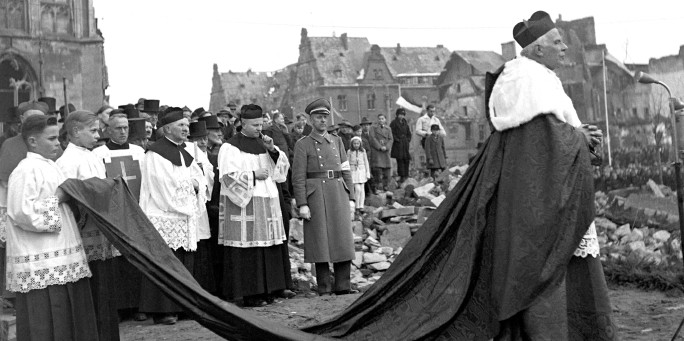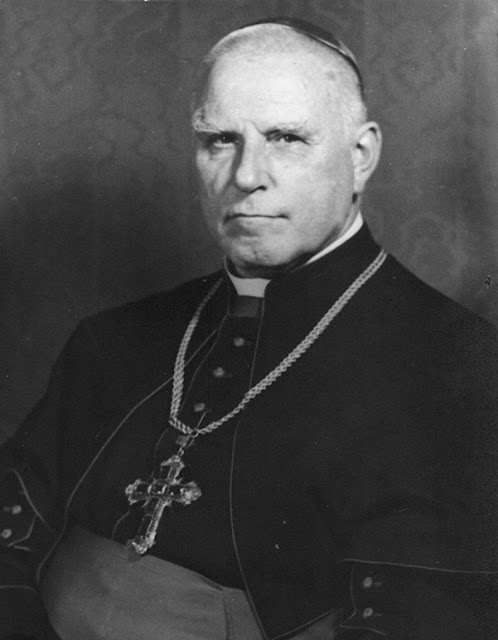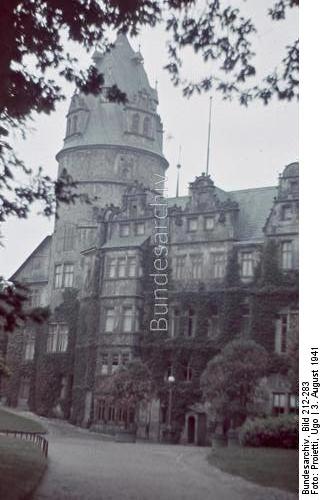Sunday 3 August 1941
 |
| Clemens August Graf von Galen, Bishop of Münster. |
In the Army Group North sector, Soviet 325th Rifle Regiments is evacuated by sea from Litsa Bay.
In the Army Group Center sector, General Guderian's advance on Roslavl bears fruit when XXIV Corps (General Geyr von Schweppenburg) links up with 4th Army's (General Feld Marshal Gunther Hans von Kluge) IX Corp. This forms the Roslavl Pocket, trapping about 38,000 Soviets who quickly become POWs. This junction wipes out Group Kachalov and much of Soviet 28th Army. The Soviets also lose about 35,000 in a pocket at Mogilev which 4th Army finally subdues.
 |
| An advance unit of German soldiers attacking a village west of Kyiv, August 1941 (Hähle, Johannes, Federal Archive, Bild 146-1974-099-45). |
Romanian 4th Army (General Nicolae Ciuperca) crosses the Dniester River and continues advancing eastward. This shows Romanian leader Ion Antonescu's willingness to aid Operation Barbarossa even in the conquest of lands that are not historically (at least arguably) Romanian.
The Luftwaffe bombs Moscow again. However, this attack is much smaller than previous attacks and can best be described as a nuisance raid.
Oblt. Kurt Sochatzy of III./JG 3 shoots down an IL-2 over Kyiv for his 38th - and last - victory. His own plane is disabled when a Soviet plane hits his Bf 109 and shears off its wing. Sochatzy successfully bails out and is taken a prisoner of war.
 |
| 3rd Panzer Division Panzer 3 Tanks crossing makeshift pontoon war bridge, Beresina River, August 1941. |
The Luftwaffe also sends some small raids against England during the night. Some bombs drop at Spittal near Berwick, damaging about a hundred houses and a church and destroying some ships and four houses.
Battle of the Baltic: The Soviets lose U-1, a motor torpedo boat, today. In addition, Soviet minesweeper T-212 Shtag hits a mine and sinks in the Soela-Vjajn Strait.
 |
| Germans at a sign warning of partisans in the area, August 1941. "Soviet Union center, Welish-Usswjat - field gendarmerie on a motorbike with sidecar in a partisan area (sign: "Partisan danger from Welish to Ußwjati" (Trautvetter, Federal Archive, Bild 101I-007-2477-06). |
Royal Navy CAM (Catapult-Armed Merchantman) ship HMS Maplin uses its catapult to launch a modified Hawker Hurricane (called a "Hurricat"), which shoots down a Focke-Wulf Fw-200 Condor. This is the first success of a CAM ship. Volunteer pilot R.W.H. Everett of RAF No. 804 Squadron lands his plane near destroyer Wanderer, escorting Convoy SL-81, and is picked up after he struggles to get out of the aircraft before it quickly sinks.
Royal Navy destroyer HMS Wanderer and corvette Hydrangea, and Norwegian destroyer St. Albans team up to sink U-401 (Kptlt. Gero Zimmermann) southwest of Ireland. The depth charge attack kills all 45 men on the U-boat. U-401 sinks on its first patrol, with no successes to its credit.
Operation EF (the raid on Kirkenes and Petsamo) ends as Force K returns to Seidisfjord, then proceeds back to Scapa Flow.
Convoy WS-10 (Winston Special) forms at sea. Its ultimate destinations are Bombay and Aden. Convoy OS-2 departs from Liverpool bound for Freetown.
Canadian minesweeper HMCS Quinte is launched.
 |
| Schenectady 1912 at St. Paul, August 3, 1941 (Robert Graham). |
The Luftwaffe (Heinkel He 111s of II/KG.26) bombs and sinks 1087-ton Belgian ship Escaut in Attika Bay, Suez. All three aboard perish.
The Luftwaffe (Heinkel He 111s of II/KG.26) bombs and sinks 5322-ton Belgian tanker Alexandre Andre about eight miles south of Suez. The ship is burned out and can only be used as a storage hulk for the remainder of the war.
The Luftwaffe (Heinkel He 111s of II/KG.26) bombs and damages 8120-ton British tanker Desmoulea at Suez. The ship has to be towed to Bombay for repairs.
The RAF bombs and sinks 216-ton Italian freighter Elisa off Benghazi.
Dutch submarine O-21 (Lt Cdr Van Dulm) uses its deck gun to sink two small Italian ships south of Sardinia. However, a larger sailing vessel gets away.
Greek submarine Nereus claims to sink a sailing ship and a transport off Rhodes. However, there is no confirmation.
Bf 100 fighters of ZG-26 attack Mersa Matruh and damage Royal Navy submarine chaser Sotra during the night.
Operation Guillotine, the British reinforcement of Cyprus, continues as Royal Navy sloop Flamingo escorts transport Kevinbank to Famagusta.
The RAF sends 21 Maryland bombers to attack the Axis front lines at Tobruk.
Winston Churchill praises Malta in a telegram, stating in part:
Now that the convoys have reached you safely with all the stores and reinforcements, I take occasion to congratulate you on the firm and steadfast manner in which you and your devoted garrison and citizens have maintained Malta inviolate against all attacks for more than a year and to express my confidence that with the help of God our cause will continue to prosper and that the contribution of Malta to the final victory will add a noble chapter to the famous story of the Island.Malta is now well-supplied, at least compared to its situation during 1940.
 |
| Bf 109D of the 3/JFS 5 at Toussus le Noble, August 1941. |
Holocaust: There are incidents in several places today. At Slobodka, Ukraine, the Germans fill a local synagogue with Jews and then set it on fire.
In Jelgava, Latvia, SS Einsatzkommandos (Lt. Hamann) execute 1550 Jews.
At Chernivtsi, Romania, Einsatzgruppen arrest 1200 Jews and execute 682 of them.
At Mitau, Latvia, the Germans execute 1500 Jews.
At Stanislawów, Ukraine, the Germans round up professional Jews and execute several hundred of them.
Isi Brauman, who writes a diary that later is published, arrives at Auschwitz. He writes: "I am going to die. There is no doubt." He received the diary from his mother for Hanukkah in 1940.
 |
| Bishop von Galen. |
"Thou shalt not kill." God engraved this commandment on the souls of men long before any penal code... God has engraved these commandments in our hearts... They are the unchangeable and fundamental truths of our social life... Where in Germany and where, here, is obedience to the precepts of God? [...] As for the first commandment, "Thou shalt not have strange gods before me," instead of the One, True, Eternal God, men have created at the dictates of their whim, their own gods to adore: Nature, the State, the Nation, or the Race.About euthanasia (German program Aktion T4) in particular he says:
It is a terrible doctrine which seeks to justify the murder of innocent people and which allows the violent killing of invalids, cripples, the incurably ill, the old and the weak who are no longer able to work ... once the principle that it is permissible to kill "unproductive" humans has been admitted and applied then we must all pity ourselves when we, too, grow old and weak.Von Galen spends the remainder of his sermon denouncing the depredations of the current German regime against the Church and vulnerable people in society. He focuses on harsh euthanasia policies and calls it murder. If a regime can dispense with the Fifth Commandment, thou shalt not kill, no other commandment survives. Once you start down that path, he concludes, others could be at risk of similar policies - such as injured Wehrmacht soldiers.
Father Bernhard Lichtenberg, dean of St. Hedwig’s Cathedral in Berlin, also denounces the euthanasia program in a sermon today. However, his sermon does not receive as much publicity as Bishop von Galen's does.
Copies of the sermon spread throughout the Reich, particularly the heavily Catholic southern regions such as Bavaria. This is considered a seminal moment in the German resistance, though it is not a direct call to action. The German authorities notice, of course, and restrict von Galen's movements. Hitler later comments:
The fact that I remain silent in public over Church affairs is not in the least misunderstood by the sly foxes of the Catholic Church, and I am quite sure that a man like Bishop von Galen knows full well that after the war I shall extract retribution to the last farthing.Despite menacing indications in the surviving German record as to von Galen's likely fate, he survives the war, perhaps through an oversight (Hitler evens many old scores during the final months of the war, but not this one). Hitler does not harm him in part due to von Galen's moral legitimacy that is recognized by many religious Germans who could be alienated. True to his principles, he then castigates the Allied occupation forces for their mistreatment of civilians. He also argues on behalf of certain imprisoned Wehrmacht officers at their trials. His life is cut short on 22 March 1946 by an appendix infection.
Von Galen is beatified (one step down from being a saint) by Pope Benedict XVI in 2005. The Catholic Church moves very deliberately in such matters and he may someday become a saint.
 |
| No fuel sales are permitted after 19:00 on 3 August along the east coast of the United States in order to conserve fuel. (Photo by John Rooney/AP Photo). |
 |
| The royal residence at Detmold (Proietti, Ugo, Federal Archive, Bild 212-283). |
August 1941
August 2, 1941: Uman Encirclement Closes
August 3, 1941: Bishop von Galen Denounces Euthanasia
August 4, 1941: Hitler at the Front
August 5, 1941: Soviets Surrender at Smolensk
August 6, 1941: U-Boats in the Arctic
August 7, 1941: Soviets Bomb Berlin
August 8, 1941: Uman Pocket Captured
August 9, 1941: Atlantic Conference at Placentia Bay
August 10, 1941: Soviet Bombers Mauled Over Berlin
August 11, 1941: Rita Hayworth in Life
August 12, 1941: Atlantic Charter Announced
August 13, 1941: The Soybean Car
August 14, 1941: The Anders Army Formed
August 15, 1941: Himmler at Minsk
August 16, 1941: Stalin's Order No. 270
August 17, 1941: Germans in Novgorod
August 18, 1941: Lili Marleen
August 19, 1941: Convoy OG-71 Destruction
August 20, 1941: Siege of Leningrad Begins
August 21, 1941: Stalin Enraged
August 22, 1941: Germans Take Cherkassy
August 23, 1941: Go to Kiev
August 24, 1941: Finns Surround Viipuri
August 25, 1941: Iran Invaded
August 26, 1941: The Bridge Over the Desna
August 27, 1941: Soviets Evacuate Tallinn
August 28, 1941: Evacuating Soviets Savaged
August 29, 1941: Finns take Viipuri
August 30, 1941: Operation Acid
August 31, 1941: Mannerheim Says No
2020
No comments:
Post a Comment